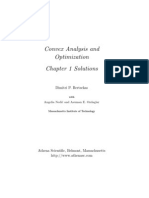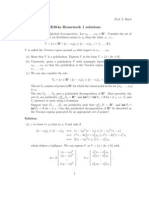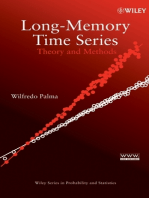Abbott - Understanding Analysis Problem Set
Uploaded by
Feynman LiangAbbott - Understanding Analysis Problem Set
Uploaded by
Feynman LiangFeynman Liang MATH 355 Assignment #7 11/4/2013
Abbott: 4.3.2, 4.3.6(a), 4.3.7, 4.4.4, 4.4.6, 4.4.8, 4.4.13(a)
4.3.2 Given f : A R, g : B R, f ( A) B s.t. g f ( x ) is well dened on A. f cts at c A, g cts at f (c) B = g f cts at c. (a) Supply a proof using - characterization of continuity. (b) Give another proof using sequential characterization of continuity (Theorem 4.3.2 (iv)). (a) If c is an isolated point, then N (c) : N (c) A = {c}. Then since c is the only element in N (c), x N (c), g f ( x ) = g f (c) N ( g f (c)) for any > 0, showing g f cts (Thm 4.3.2). Thus, assume c is a limit point. Since f cts at c, c A. Let > 0 be arbitrary. Since g cts at f (c), 0 > 0 s.t. | f ( x ) f (c)| < 0 = | g f ( x ) g f (c)| < . Since f cts at c, 0 > 0 s.t. | x c| < 0 = | f ( x ) f (c)| < 0 . Taken together:
| x c| < 0 = | f ( x ) f (c)| < 0 = | g f ( x ) g f (c)| <
So x N0 (c) = g f ( x ) N ( g f (c)). Since arbitrary, by Theorem 4.3.2 g f cts. (b) If c is an isolated point, then for any sequence ( xn ) A converging to c, N0 N : n N0 , xn = c. This implies n N0 , g f ( xn ) = g f (c) and therefore ( g f ( xn )) g f (c), proving g f cts (Thm 4.3.2). Thus, assume c is a limit point. Let ( xn ) be an arbitrary sequence s.t. ( xn ) c, c A, f cts at c. Since f cts at c , ( xn ) c = ( f ( xn )) f (c). Since g cts at f (c) and ( f ( xn )) f ( A) B, ( f ( xn )) f (c) = ( g f ( xn )) g f ( c ). Taken together:
( xn ) c = ( f ( xn )) f (c) = ( g f ( xn )) g f (c)
So ( xn ) c = ( g f ( xn )) g f (c). Since ( xn ) and c arbitrary, by Theorem 4.3.2 g f cts. 4.3.6(a) Prove that Dirichlets function: g( x ) = is nowhere continuous. 1 1 0 if x Q if x Q
Let x R arbitrary. Case I: x Q Since Q is dense in R, > 0, N ( x ) Q = . Thus, we can produce a sequence which converges to x by letting n N be arbitrary and choosing any arbitrary xn N1/n ( x ), which is non-empty. Notice that ( xn ) x and g( x ) = 0. However, n N, xn Q so g( xn ) 1. Thus by Corrolary 4.3.3, g is not cts at x. Since x R arbitrary, g is nowhere cts. Case II: x Q Since R \ Q is dense in R, > 0, N ( x ) (R \ Q) = . Thus, we can produce a sequence which converges to x by letting n N be arbitrary and choosing any arbitrary xn N1/n ( x ). Notice that ( xn ) x and g( x ) = 1. However, n N, xn (R \ Q) so g( xn ) 0. Thus by Corrolary 4.3.3, g is not cts at x. Since x R arbitrary, g is nowhere cts. 4.3.7 Assume h : R R cts and let K = { x : h( x ) = 0}. Show that K is closed. If K = then it is closed so assume that K is non-empty. Let c be an arbitrary limit point of K, which implies ( xn ) (K \ {c}) : ( xn ) c. Then since h cts, (h( xn )) h(c). Furthermore, notice that ( xn ) K so h( xn ) = 0, n N. Thus, (h( xn )) = (0, 0, 0, . . .) and (h( xn )) 0, implying h(c) = 0. Since h(c) = 0, then c K. Since c arbitrary, K contains all its limit points and is closed. 4.4.4 Prove f cts on [ a, b] , x [ a, b] : f ( x ) > 0 = 1 bdd on [ a, b] f
[ a, b] is closed and bounded, so by HBT it is compact. Since f is cts on [ a, b], EVT (Theorem 4.4.3) implies that that: x0 [ a, b ] : x [ a, b ], f ( x0 ) f ( x )
Since f ( x ) > 0 for x [ a, b], f ( x0 ) > 0 as well. Inverting the inequality yields x [ a, b], f (1 f (1x) , showing 1 f bdd. x )
0
4.4.6 Give an example or show impossibility: (a) f : (0, 1) R cts and ( xn ) Cauchy s.t. f ( xn ) is not Cauchy. (b) f : [0, 1] R cts and ( xn ) Cauchy s.t. f ( xn ) is not Cauchy. (c) f : [0, ) R cts and ( xn ) Cauchy s.t. f ( xn ) is not Cauchy. (d) f : (0, 1) R cts, bdd that attains a maximum value but not a minimum on (0, 1). 2
1 (a) Let f : x 1 x , xn = n . Then f is cts on (0, 1) and ( xn ) 0 ( xn ) Cauchy. However, f ( xn ) = n so ( f ( xn )) diverges ( f ( xn )) not Cauchy.
(b) Impossible. ( xn ) Cauchy ( xn ) x. ( xn ) [0, 1] and [0, 1] closed, so x [0, 1]. Since f cts in [0, 1] and x [0, 1], Theorem 4.3.2 implies ( f ( xn )) f ( x ). Since ( f ( xn )) converges, it is Cauchy. Thus, ( f ( xn )) is Cauchy for all ( xn ) Cauchy. (c) Impossible. Same proof as (b), only changing domain from [0, 1] to [0, ) which is still closed and hence if ( xn ) x is a Cauchy sequence in [0, ) than x [0, ). The rest of the proof is identical. (d) Let f : x x (1 x ). Then the maximum occurs when 0 = 1 2x = x = 1 1 2 , yielding a maximum value for f of f (1/2) = 4 . However, any proposed minimum x0 m0 = f ( x0 ) is not minimal since if m0 0.5 then f ( x0 + 1 2 ) is smaller and similarily if x0 m0 < 0.5 then f ( x0 1 2 ) is smaller. 4.4.8 (a) Assume f : [0, ) R cts on its domain. Show
b > 0 : f uniformly cts on [b, ) = f uniformly cts on [0, )
(b) Prove f : x
x is uniformly cts on [0, ).
(a) Let > 0 be arbitrary. [0, b] is compact (HBT) and so by Theorem 4.4.8 f is uniformly cts on [0, b]. f uniformly cts on [0, b] implies:
1 > 0 : c [0, b], x N1 (c) = f ( x ) N ( f (c))
Similarly, f uniformly cts on [b, ) implies:
2 > 0 : c [0, ), x N2 (c) = f ( x ) N ( f (c))
Choosing = max{1 , 2 }, we get:
c [0, ) = [0, b] [b, ), x N (c) = f ( x ) N ( f (c))
Since
> 0 arbitrary, f is uniformly cts on [0, ). > 0 and x, c 1 be arbitrary. Choose = . Then x : | x c| < x+ y c = ( x y) x+ y =
xy x+ y
(b) Consider [1, ). Let :
| f ( x ) f (c)| =
< | x y| ==
3
Since > 0 and x, c [1, ) arbitrary, f is uniformly cts on [1, ). By part (a), f is uniformly cts on [0, ).
4.4.13(a) Show that if f : A R is uniformly cts and ( an ) A Cauchy, then f ( an ) is Cauchy. Let f : A R be uniformly cts on A and ( xn ) A an arbitrary Cauchy sequence. Let > 0 be arbitrary. f uniform cts means > 0 : x, y A, | x y| < = | f ( x ) f (y)| < . an Cauchy means N0 N : m > n N0 , | am an | < . Letting x = am , y = an in the uniform cts statement above, since ( an ) A we have:
m > n N0 , | f ( am ) f ( am )| <
Since
> 0 arbitrary, ( f ( an )) is Cauchy.
You might also like
- Refutation of - Some Observations, - by Frithjof Schuon - Criticizing René Guénon - Pages 16 To The End.No ratings yetRefutation of - Some Observations, - by Frithjof Schuon - Criticizing René Guénon - Pages 16 To The End.42 pages
- Canon - Elura 10A, 20MCA - Service ManualNo ratings yetCanon - Elura 10A, 20MCA - Service Manual177 pages
- Latinos and The Nation's Future Edited by Henry G. Cisneros and John Rosales100% (2)Latinos and The Nation's Future Edited by Henry G. Cisneros and John Rosales273 pages
- Mathematics 315 - Assignment 1: X A X A X A X A X ANo ratings yetMathematics 315 - Assignment 1: X A X A X A X A X A4 pages
- Calculus I: Advanced Level Pure MathematicsNo ratings yetCalculus I: Advanced Level Pure Mathematics28 pages
- Solutions for Problems on Fermats Thm and the MvtsNo ratings yetSolutions for Problems on Fermats Thm and the Mvts11 pages
- Indian Institute of Technology Bhubaneswar School of Basic Sciences Mathematics-1 (MA1L001) (Autumn-2019) Assignment-1No ratings yetIndian Institute of Technology Bhubaneswar School of Basic Sciences Mathematics-1 (MA1L001) (Autumn-2019) Assignment-13 pages
- EC744 Lecture Note 2 Deterministic Models: Mathematical PreliminariesNo ratings yetEC744 Lecture Note 2 Deterministic Models: Mathematical Preliminaries18 pages
- Assignment I: (To Be Submitted in Tutorial Class by September 13, 2019)No ratings yetAssignment I: (To Be Submitted in Tutorial Class by September 13, 2019)2 pages
- Problem Set 1: 1 Answers To The Required ProblemsNo ratings yetProblem Set 1: 1 Answers To The Required Problems8 pages
- Convex Analysis and Optimization Solution Manual100% (2)Convex Analysis and Optimization Solution Manual193 pages
- Some Results On Shadowing and Local Entropy Properties of Dynamical SystemsNo ratings yetSome Results On Shadowing and Local Entropy Properties of Dynamical Systems29 pages
- Introductory Mathematics, MAT100a, D, Fall 2020 October 8No ratings yetIntroductory Mathematics, MAT100a, D, Fall 2020 October 88 pages
- 7 The Fundamentals of Topology: 7.1 Open and Closed SetsNo ratings yet7 The Fundamentals of Topology: 7.1 Open and Closed Sets5 pages
- Calculus I Summary: Tabulated by Lambert Peng at Brown in Summer 2008No ratings yetCalculus I Summary: Tabulated by Lambert Peng at Brown in Summer 20083 pages
- Asynchronous Anytime Sequential Monte CarloNo ratings yetAsynchronous Anytime Sequential Monte Carlo11 pages
- Dummit & Foote Chapter 2 Selected SolutionsNo ratings yetDummit & Foote Chapter 2 Selected Solutions5 pages
- Diet and Lifestyle Choices Interview: September 2, 2013No ratings yetDiet and Lifestyle Choices Interview: September 2, 20131 page
- 14 - Fly Guy's Big Family _ Book Study ActivitiesNo ratings yet14 - Fly Guy's Big Family _ Book Study Activities62 pages
- 12 Physics Notes Ch01 Electric Charges and FieldNo ratings yet12 Physics Notes Ch01 Electric Charges and Field3 pages
- Technica Notes: Reaction of Aluminum With Sodium Hydroxide Solution As A Source of Hydrogen100% (2)Technica Notes: Reaction of Aluminum With Sodium Hydroxide Solution As A Source of Hydrogen3 pages
- MCQ For SNVM Startup and New Venture ManagementNo ratings yetMCQ For SNVM Startup and New Venture Management24 pages
- National Grade Six Assessment Social Studies P1No ratings yetNational Grade Six Assessment Social Studies P117 pages
- Fork Lift Preventive Maintenance 3 Checklist: Carwill Construction IncNo ratings yetFork Lift Preventive Maintenance 3 Checklist: Carwill Construction Inc2 pages
- Grammatical Signals Pattern of Development PartNo ratings yetGrammatical Signals Pattern of Development Part4 pages
- Machine Learning Guide: Meher Krishna PatelNo ratings yetMachine Learning Guide: Meher Krishna Patel121 pages
- Manual of Pesticide Residue Analysis Volume II PDFNo ratings yetManual of Pesticide Residue Analysis Volume II PDF493 pages
- First-Order Logic in Artificial IntelligenceNo ratings yetFirst-Order Logic in Artificial Intelligence38 pages
- Refutation of - Some Observations, - by Frithjof Schuon - Criticizing René Guénon - Pages 16 To The End.Refutation of - Some Observations, - by Frithjof Schuon - Criticizing René Guénon - Pages 16 To The End.
- Latinos and The Nation's Future Edited by Henry G. Cisneros and John RosalesLatinos and The Nation's Future Edited by Henry G. Cisneros and John Rosales
- Mathematics 315 - Assignment 1: X A X A X A X A X AMathematics 315 - Assignment 1: X A X A X A X A X A
- Solutions for Problems on Fermats Thm and the MvtsSolutions for Problems on Fermats Thm and the Mvts
- Indian Institute of Technology Bhubaneswar School of Basic Sciences Mathematics-1 (MA1L001) (Autumn-2019) Assignment-1Indian Institute of Technology Bhubaneswar School of Basic Sciences Mathematics-1 (MA1L001) (Autumn-2019) Assignment-1
- EC744 Lecture Note 2 Deterministic Models: Mathematical PreliminariesEC744 Lecture Note 2 Deterministic Models: Mathematical Preliminaries
- Assignment I: (To Be Submitted in Tutorial Class by September 13, 2019)Assignment I: (To Be Submitted in Tutorial Class by September 13, 2019)
- Some Results On Shadowing and Local Entropy Properties of Dynamical SystemsSome Results On Shadowing and Local Entropy Properties of Dynamical Systems
- Introductory Mathematics, MAT100a, D, Fall 2020 October 8Introductory Mathematics, MAT100a, D, Fall 2020 October 8
- 7 The Fundamentals of Topology: 7.1 Open and Closed Sets7 The Fundamentals of Topology: 7.1 Open and Closed Sets
- Calculus I Summary: Tabulated by Lambert Peng at Brown in Summer 2008Calculus I Summary: Tabulated by Lambert Peng at Brown in Summer 2008
- Diet and Lifestyle Choices Interview: September 2, 2013Diet and Lifestyle Choices Interview: September 2, 2013
- Technica Notes: Reaction of Aluminum With Sodium Hydroxide Solution As A Source of HydrogenTechnica Notes: Reaction of Aluminum With Sodium Hydroxide Solution As A Source of Hydrogen
- Fork Lift Preventive Maintenance 3 Checklist: Carwill Construction IncFork Lift Preventive Maintenance 3 Checklist: Carwill Construction Inc
- Manual of Pesticide Residue Analysis Volume II PDFManual of Pesticide Residue Analysis Volume II PDF































































































